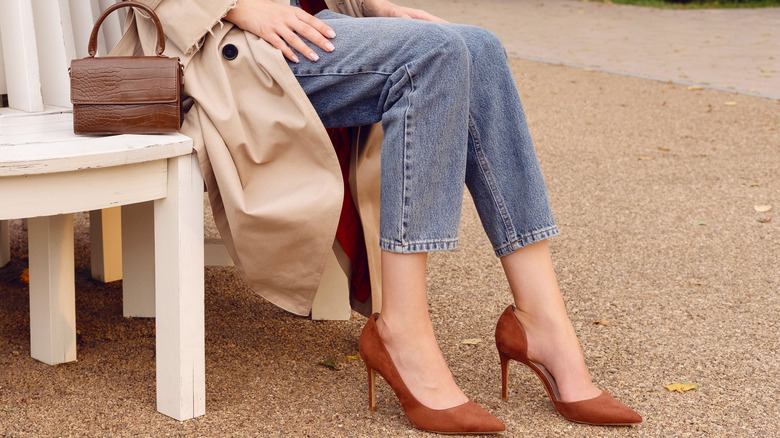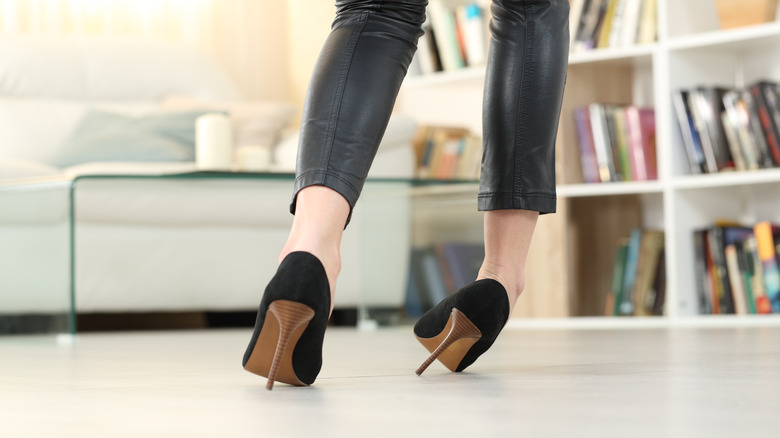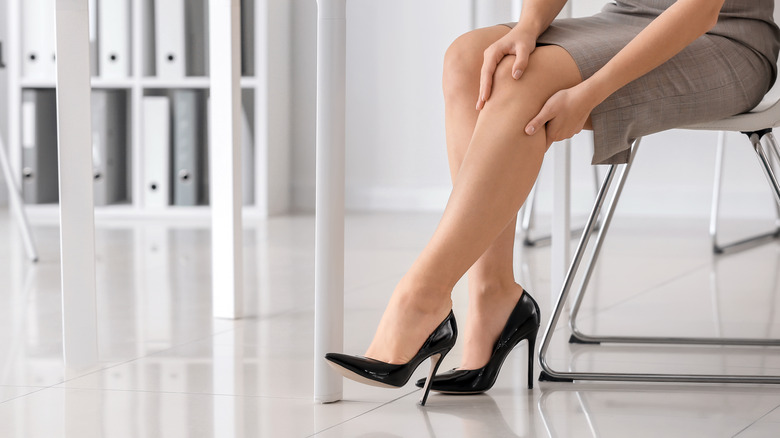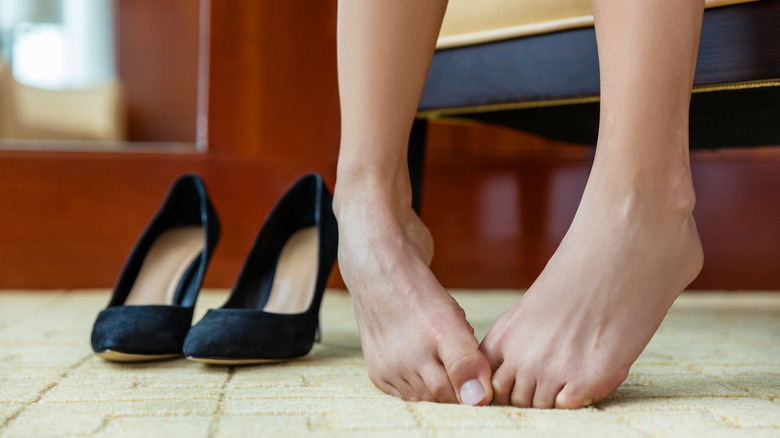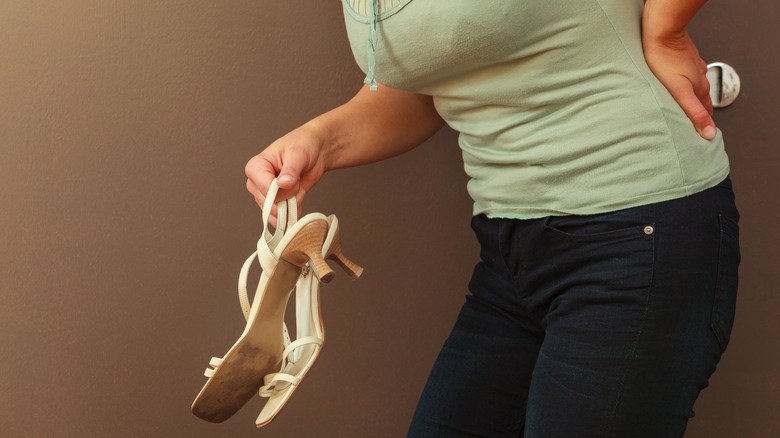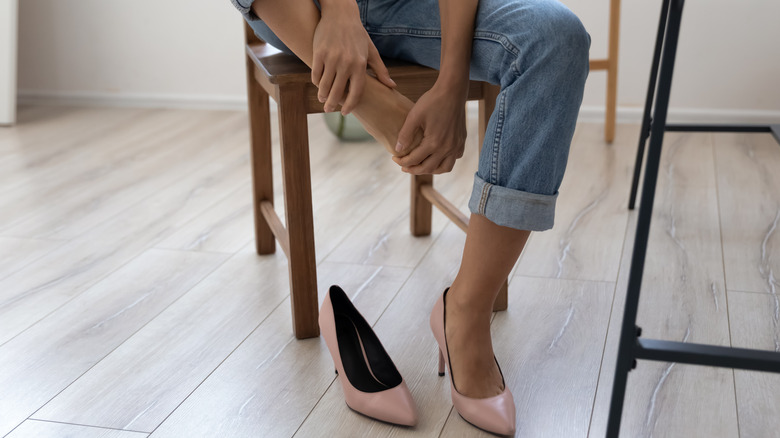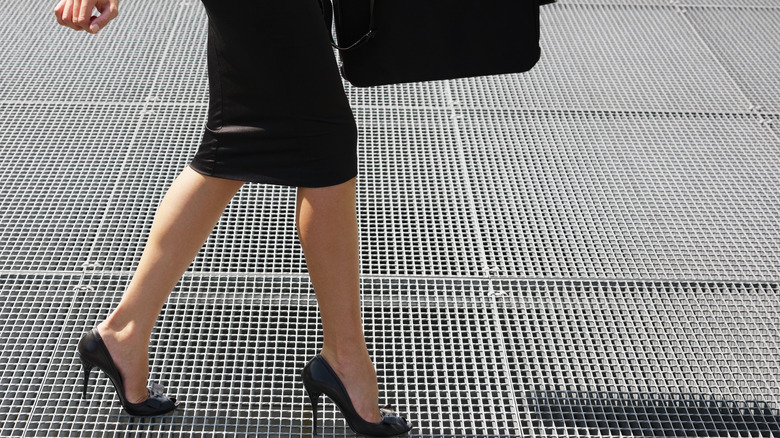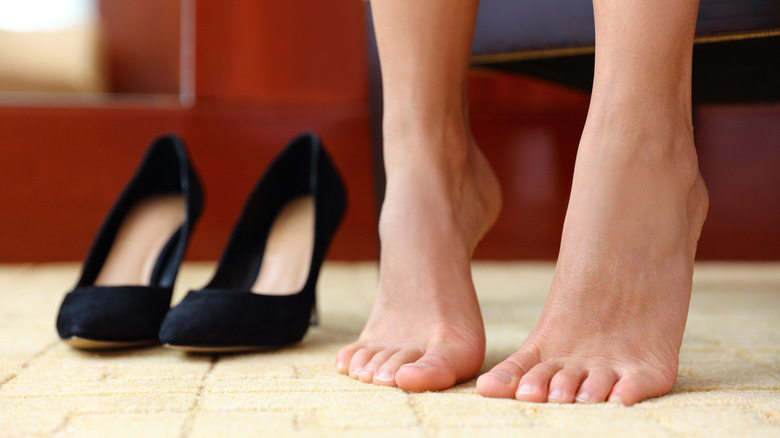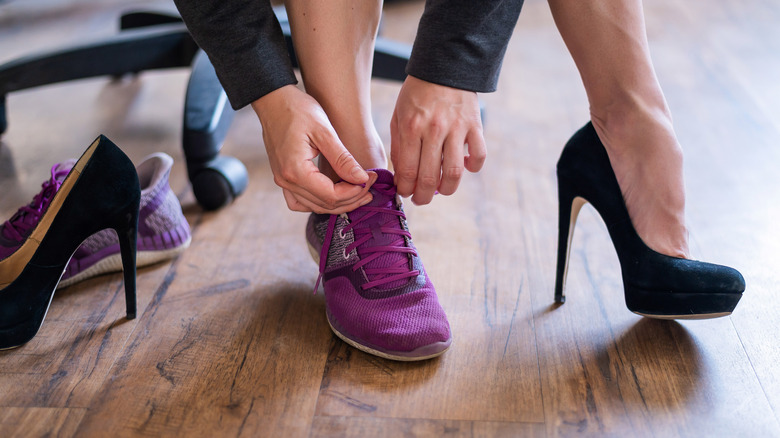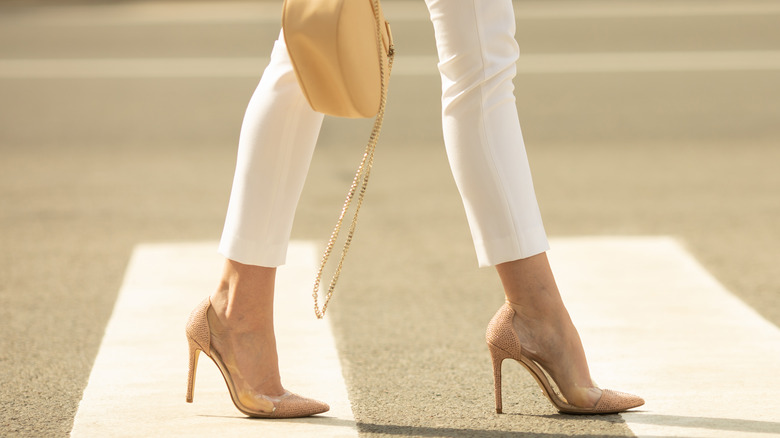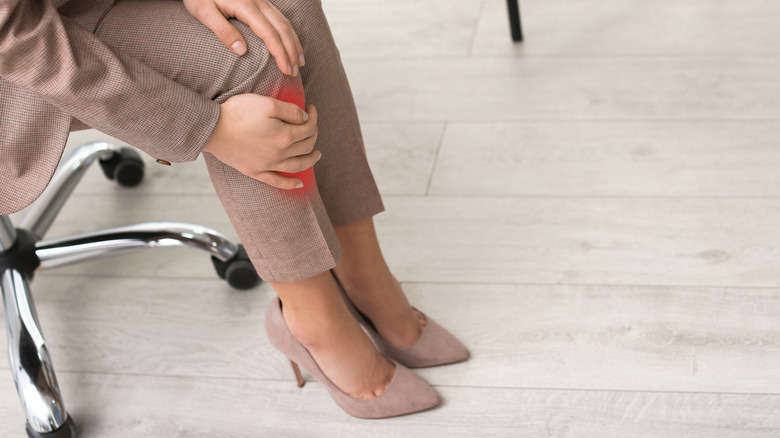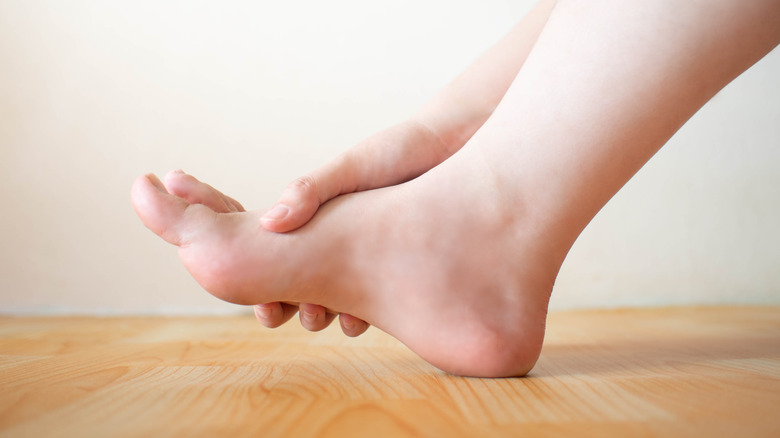What Happens To Your Body When You Wear Heels Every Day
For many fashionistas, footwear is an essential part of what makes the outfit come together. Depending on the occasion, high heels are a common shoe of choice. In fact, 72% of women wear high heels at some time in their lives, with the majority of women polled (77%) opting for heels for special occasions (via The Spine Health Institute).
Although high heels are the popular footwear choice, you may not realize the ramifications to your health when you choose those sexy pumps. Nearly one-third of women who wear heels have reported permanent damage (via ShareCare). The stats are stacked against high heels, along with the opinions of footwear experts. According to the American Podiatric Medical Association, "the best shoe for women is a walking shoe with laces, a polymerized composition sole, and a relatively wider heel with a rigid and padded heel counter at no more than three-quarters of an inch in height." But before you head to your closet to toss out all of your high heels, there is some good news. While podiatrist Scott Hamilton tells ShareCare there is "very little upside to wearing heels," if you opt for two-inch heels or less you may forgo the serious health impacts three- to four-inch heels can cause.
Let's dive into some of the repercussions you might experience if you decide to stick with your high heels. Don't worry, we'll toss in some tips and tricks to make your footwear experience less painful.
Ankle injuries and stress fractures
It's no secret that high heels are tough on your feet. The pressure of your weight on the ball of your foot increases the higher the heel goes (via FootCare MD). This excessive pressure can cause stress fractures in the metatarsal bones that connect your toes to the back of your foot (via Medline Plus). According to FootCare MD, you can avoid stress fractures by choosing a lower heel to reduce the pressure on the ball of your foot, and by picking a shoe that has a shape similar to your toes. Those pointed heels that crowd your toes increase that foot pressure.
Wearing heels also increases your risk for ankle injury, especially if you don't wear them often and aren't used to balancing in the changed posture. Lateral ankle sprains — when you strain or break the ligaments around the outer foot — can happen easily if you step a bit wrong and lose your balance, podiatrist Dr. Yolanda Ragland tells Insider. The injury data backs it up — the University of Alabama found that sprains and strains of the foot or ankle were the majority of the 123,355 high-heel-related injuries treated in emergency rooms from 2002 to 2012. So be careful with those heels!
Osteoarthritis in the knees
Strain caused by high heels can also wear down the cartilage in your joints, particularly in your knees, ankles, and down into your feet, according to Insider. Your feet alone have 33 different joints that can be impacted by wearing heels (via Healthgrades). Some research found this heightened osteoarthritis risk still applies even to lower-heeled or wider shoes, according to Healthgrades.
Osteoarthritis is described by the Centers for Disease Control and Prevention (CDC) as the most common form of arthritis, with symptoms including pain, stiffness, decreased flexibility and motion, and swelling. Women are already more likely to develop osteoarthritis, according to the CDC, so you may want to cut your chances and limit your high heel use. Another option to help make your heels more supportive is to use orthotics or store-bought inserts in your shoes (via Coastal Orthopedics). These will help distribute your body weight to your heel and minimize the wear and tear on your joints.
Foot and toe deformities
Wearing tight shoes causes discomfort, and myriad foot problems to accompany it. Bunions are bump deformities on the big toe joint that cause the big toe to lean toward the second toe (via ShareCare). And though the propensity to develop bunions is an inherited trait, wearing high heels can trigger them or make them worse, according to Harvard Health. With bunions being 10 times more common in women than in men, there does appear to be a link between footwear choice and the condition.
Hammertoe — when your toes bend downward permanently — can also result from wearing high heels (via Mayo Clinic). This can occur when your toes are so crowded they can't lie flat, instead curling downward even when barefoot. Treatment options can be as simple as changing your shoes, or as serious as surgery. Some people may also experience Haglund's deformity, when a bump forms on the back of your heel due to constant pressure (via Hackensack Meridian Health). This is common in those who wear high heels frequently, hence why it is known by the name of "pump bump."
If you already have bunions or hammertoes, wearing heels can worsen your condition. Be sure to wear shoes that fit properly — high heels or not — and when buying a new pair, try them on in the afternoon, as that is when your feet are the largest, according to The Spine Health Institute.
Back problems due to poor posture
Posture and back problems can start down at the foot level. Wearing high heels changes the normal "S" shape of your spine, displacing the curve in your lower back to respond to your body leaning more forward, according to The Spine Health Institute. This corresponds to a visible change in your posture to keep your body balanced. "When you wear heels, you have to curve your lower vertebrae to maintain an upright posture, so it puts a definite strain on the lower back," podiatrist Scott Hamilton tells ShareCare.
More serious problems can also develop, such as a spinal nerve condition in the lower back called foraminal stenosis. This condition leads to pain, numbness, tingling, spasms, weakness, or sciatica, pain and cramping that spreads down through the legs (via the Spine Health Institute). Spondylolisthesis, when your vertebrae slips over another, is also a common occurrence from wearing high heels. Spinal lordosis — a curving in the lower back — has also been reported to be caused by high heels, though scientific evidence of this connection is mixed according to Associate Professor Lloyd Reed from the QUT School of Clinical Sciences in podiatry (per Huff Post).
Shortened Achilles tendon leading to other injuries
Longtime heel-wearers can experience permanent changes to their muscles and body, specifically in their Achilles tendon. High heels push your foot weight forward, leaving tension off of your Achilles tendon and causing it to shorten as a result. In turn, this shortened Achilles tendon can lead to injuries like plantar fasciitis or tendonitis (via Hackensack Meridian Health). Plantar fasciitis is when the plantar fascia — the tissue that runs through your foot connecting your heel to your toes — becomes inflamed, causing heel pain (via Mayo Clinic). It is a common injury for those who don't wear shoes with enough support. A shortened Achilles tendon can also lead to tendonitis, or irritation of a tendon that causes pain and tenderness near a joint, according to the Mayo Clinic.
Daily foot stretches focused on your Achilles tendon can provide some relief, according to Hackensack Meridian Health. Start by putting your hands on a wall, pushing one leg back and pressing your heel to the floor. Stay in that position for a minute or two before changing legs.
Issues with your balance
Wearing high heels is like walking on your tip-toes for hours at a time — and if you've ever tried walking on your tip-toes, you know your balance is a bit off. Not only can this be damaging to feet themselves, but you are forced to overcompensate by modifying the way you naturally stand or walk (via The Spine Health Institute). Wearing high heels also can create balance issues due to lack of support in the shoe itself.
There are ways to improve your balance without completely giving up high heels or practicing walking in them. Strengthening your lower leg muscles can help with balance, according to Footcare MD. You should also try to select shoes with wider soles, such as wedges or chunkier heels (via Verywell Health). The narrow heel of a stiletto shoe doesn't provide a lot of support, while also forcing your foot into the supinated position. The lack of balance could lead to injuries or long-term foot issues.
Toenail issues and fungal infections
Ever have a painful ingrown toenail? If you are one of the lucky ones who hasn't yet experienced it yet, an ingrown toenail occurs when your toes are pushed together, causes the big toenail to grow into your skin (via Women's Health Research Institute). If you have had an ingrown toenail before, you're not alone. Researchers at the Women's Health Research Institute say ingrown toenails are some of the most common issues from wearing high heels. Fungal infections are also a possibility when your toenails don't have room to grow as they should. The infection, called onychomycosis, is hard to treat, according to FootCare MD.
Experts say that keeping your toenails short and straight across the top can help prevent toenail issues from forming (via Women's Health Research Institute). You can also soak your feet in soapy, warm water or epsom salts, or use an antiseptic solution on your toes (via Women's Health Research Institute). As for treatment of ingrown toenails, you may have to get a podiatrist involved. They can provide topical options or remove part of the infected nail.
Regular shoes may become uncomfortable
You may have heard people who love wearing high heels swear that they are more comfortable for their feet than flat shoes. Turns out, there could be some truth to that. If you wear heels much of the time, your body may eventually get used to the position of your foot and make wearing other types of shoes uncomfortable. "Because your foot is elevated and the weight goes forward, a lot of tension gets taken off the Achilles tendon and it shortens over time," podiatric surgeon Jackie Sutera, tells SELF. "That's why a lot of women who are a little older don't feel good in flats, because the tendons are so tight from overuse of high heels their whole lives"
So how can you ensure this isn't your fate? Try switching up your footwear regularly, avoiding high heels on days you plan to stand or walk a lot. You can also wear what SELF calls "commuter shoes," when you wear more comfortable walking shoes in transit and then change into those cute (but uncomfortable) high heels when you get to your destination. This could be the best of both worlds, as you don't have to sacrifice your outfit completely, and you may even get to work faster in those gym shoes!
Changes to your walk
A cute pair of high heels may make you feel like you have a powerful, modelesque stride as opposed to when you don a pair of flats or sandals. Turns out, experts say you do walk differently when wearing high heels, due to your center of gravity being higher (via Insider). It's all about the foot position. A typical stride has the foot pushing off your toes from the heel of your foot to the ball of your foot (via Verywell Health). But high heels put your foot in a plantarflexed — or downward-facing — position (via WebMD). This means you don't push off the ground as efficiently, making your hip flexors and knees work harder to push you forward, according to Verywell Health.
If you don't have the leg strength to compensate for this, your runway power walk may look a little more painful than effortless. Try doing toe raises to strengthen your calves and make it easier to walk in heels. You can also make the effort to modify the way you walk in heels to prevent longer-term effects. Solemates recommends keeping a balanced posture, placing your foot down evenly heel to toe, and taking softer and shorter steps at a slower pace.
Knee problems
Heels also mean trouble for your knees, as experts say high heels strain your shins and feet and shorten your calf muscles, eventually causing stress on your knee (via Orthopedic Associates of West Jersey). That pain can be irritating and lead to injuries further down the road, which may be irreversible. "Cartilage in your knee helps cushion forces, and if you are wearing heels every day you keep tearing on it and pulling on it and pulling on it. As such, it tends to become quite worn, and that's not something you can regenerate. It's not regenerative material," Kevin Netto, Associate Professor at the Curtin University School of Physiotherapy and Exercise Science, tells Huff Post.
Massage and stretching can be key to alleviating knee pain (via Orthopedic Associates of West Jersey). Focus on massaging your shin muscles, as well as stretching the calves. Avoiding high heels would be the ultimate treatment for your knees, however, focusing on getting supportive shoes can be a good substitute if you can't give up the heels. Added arch support may also be helpful to prevent your knee from torqueing, which can cause osteoarthritis (via Verywell Health). However, it may not be the right solution for all feet, so be sure to check with your podiatrist to weigh your options.
Pain and swelling
Experts say it's not just injuries from high heels that can cause lasting effects on your body. There are numerous other changes your body may make to accommodate wearing heels. Our feet are designed with natural cushions, but over time, those pumps start to wear away that pad (via SELF). "What ends up happening with overuse is the fat pad on bottom of the foot starts to become a lot thinner over time," Podiatric surgeon Jackie Sutera tells SELF. "When you don't have a natural cushion anymore, you can get generalized pain on the bottom of the foot." Sutera also added that pinched nerves in your foot can also be painful daily reminders to be careful about your footwear choice.
Studies have also shown there is evidence linking high heels and swelling in the legs and ankles (via Huff Post). This is due to the inefficiency in the calf muscles pumping blood back to the heart when wearing high heels. "You're going to stretch out the muscles in the front, tighten and shorten the muscles in the back and you're going to cause the legs and the ankles to swell," Associate Professor Lloyd Reed from the QUT School of Clinical Sciences in podiatry told the Huff Post. The study found that this wasn't an issue in lower-heeled shoes, adding another consideration when selecting your daily footwear.

